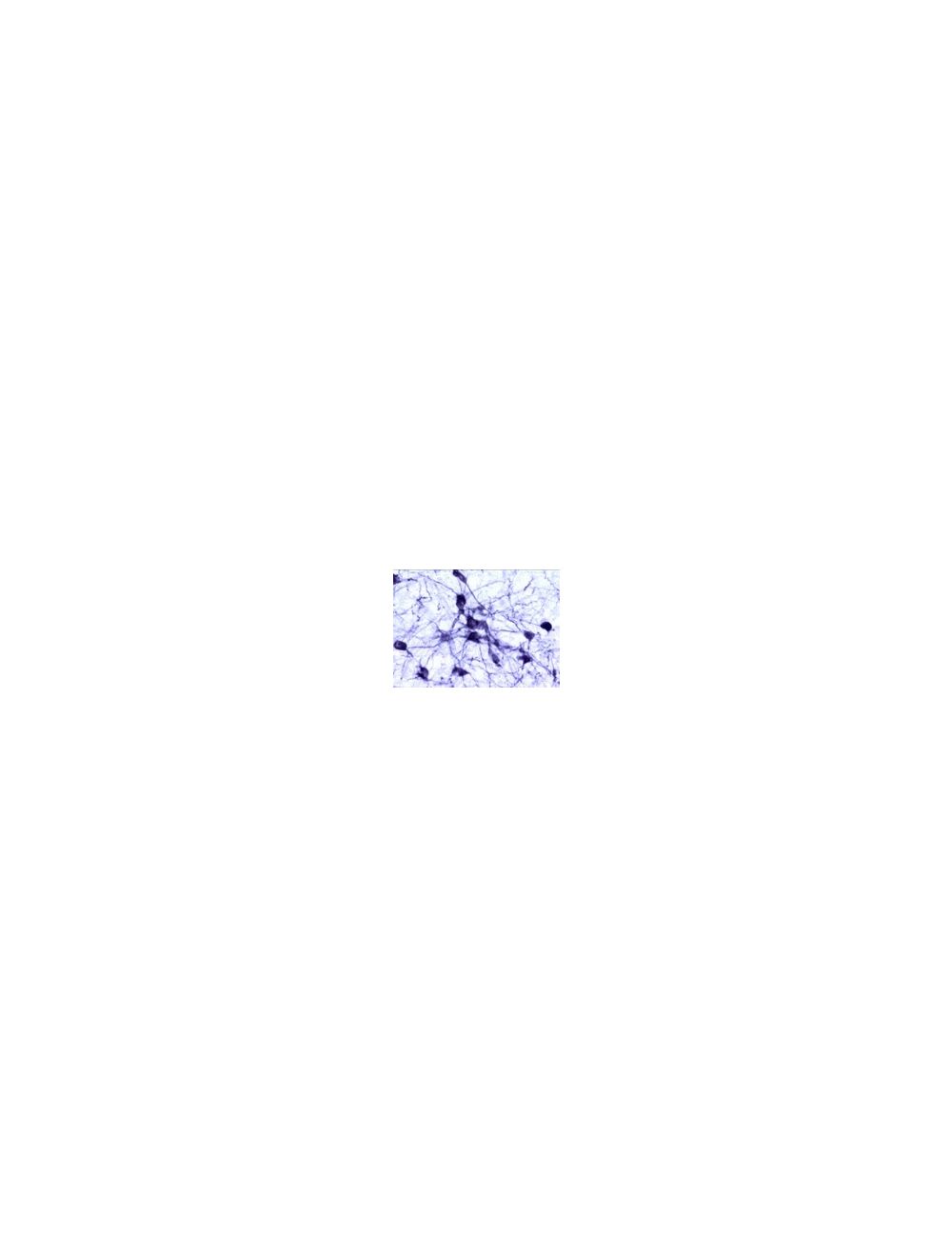Tyrosine Hydroxylase (TH), Rabbit Polyclonal Antibody
As low as
US$317.00
Only %1 left
Catalog Number
R-1645
- Product Name Tyrosine Hydroxylase (TH), Rabbit Polyclonal Antibody
- Product Description Rabbit anti-Tyrosine Hydroxylase (TH) Polyclonal Antibody (Unconjugated), suitable for IHC-Frozen.
- Alternative Names TH; Tyrosine hydroxylase; Tyrosine 3-monooxygenase; L-tyrosine hydroxylase; Tyrosine 3-hydroxylase
- Application(s) IHC-Frozen
- Antibody Host Rabbit
- Antibody Type Polyclonal
- Specificity IHC on brain shows a pattern of staining specific for TH containing neurons. This antibody is known to react with rat, mouse and guinea pig. Cross reactivity with other species has not yet been tested.
- Species Reactivity Guinea Pig, Human, Mouse, Rat
- Immunogen Description A synthetic peptide (PRFIGRRQSLIEDARK) as part of human Tyrosine Hydroxylase (63-78) conjugated to KLH has been used as the immunogen. The peptide is homologous with the corresponding sequence derived from TH protein in rat (31-47).
- Conjugate Unconjugated
- Purity Description Protein G purified
- Regulatory Status For research use only.
Product Info
- Product Description Rabbit anti-Tyrosine Hydroxylase (TH) Polyclonal Antibody (Unconjugated), suitable for IHC-Frozen.
-
Related Products
Tyrosine Hydroxylase (TH), Rabbit Polyclonal Antibody
- Application(s) IHC-Frozen
- Application Details IHC. A concentration of 4-10 µg/mL is recommended for this application. This is a superb antibody for detection of tyrosine hydroxylase containing neurons exhibiting an intense labelling with a negligible background. This antiserum has proven extremely useful for staining of catecholaminergic neurons. It stains nicely and intensely dendritic processes and fine nerve terminals. We recommend mouse or rat brain containing catecholaminergic neurons as a positive control for this antibody, for example brain stem or striatum. Western blotting: A concentration of 5-15 µg/mL is recommended.Biosensis recommends optimal dilutions/concentrations should be determined by the end user.
- Target Tyrosine Hydroxylase (TH)
- Specificity IHC on brain shows a pattern of staining specific for TH containing neurons. This antibody is known to react with rat, mouse and guinea pig. Cross reactivity with other species has not yet been tested.
- Target Host Species Human
- Species Reactivity Guinea Pig, Human, Mouse, Rat
- Antibody Host Rabbit
- Antibody Type Polyclonal
- Antibody Isotype IgG
- Conjugate Unconjugated
- Immunogen Description A synthetic peptide (PRFIGRRQSLIEDARK) as part of human Tyrosine Hydroxylase (63-78) conjugated to KLH has been used as the immunogen. The peptide is homologous with the corresponding sequence derived from TH protein in rat (31-47).
- Purity Description Protein G purified
- Format Lyophilized from PBS, pH 7.4, without preservatives.
- Reconstitution Instructions Spin vial briefly before opening. Reconstitute in 500 µL sterile-filtered 1X PBS, pH 7.2-7.6. Centrifuge to remove any insoluble material.
- Storage Instructions After reconstitution keep aliquots at -20°C for a higher stability, and at 2-8°C with an appropriate antibacterial agent. Avoid repetitive freeze/thaw cycles.
- Batch Number Please see item label.
- Expiration Date 12 months after date of receipt (unopened vial).
- Alternative Names TH; Tyrosine hydroxylase; Tyrosine 3-monooxygenase; L-tyrosine hydroxylase; Tyrosine 3-hydroxylase
- Uniprot Number P04177
- Uniprot Number/Name P04177 (TY3H_RAT)
- Scientific Background Tyrosine hydroxylase (TH) is the rate-limiting enzyme in the synthesis of the catecholamines dopamine, epinephrine and norepinephrine. Therefore the regulation of the TH enzyme represents the central means for controlling the synthesis of these important catecholamines. FUNCTION: Plays an important role in the physiology of adrenergic neurons. CATALYTIC ACTIVITY: L-tyrosine + tetrahydrobiopterin + O2 = 3,4-dihydroxy-L-phenylalanine + 4a-hydroxytetrahydrobiopterin. COFACTOR: Fe(2+) ion. ENZYME REGULATION: Phosphorylation leads to an increase in the catalytic activity. PATHWAY: Catecholamine biosynthesis; first step. SUBUNIT: Homotetramer. PTM: In vitro, phosphorylation of Ser-19 increases the rate of Ser-40 phosphorylation, which results in enzyme opening and activation. SIMILARITY: Belongs to the biopterin-dependent aromatic amino acid hydroxylase family. The presence of different DNA sequences at the TH locus confers susceptibility to various disorders of the brain including manic-depression and schizophrenia. Parkinson's disease is also considered a TH deficiency as low dopamine levels are a consistent neurochemical abnormality.
- Shipping Temperature 25°C (ambient)
- UNSPSC CODE 41116161
- Regulatory Status For research use only.
Specifications
-
Specific References
Pierre S.R., Lemmens M.A., Figueiredo-Pereira M.E. (2009) Subchronic infusion of the product of inflammation prostaglandin J2 models sporadic Parkinson's disease in mice J Neuroinflammation. Jul 25;6:18
Takeoka A. et al (2010) Noradrenergic innervation of the rat spinal cord caudal to a complete spinal cord transection: effects of olfactory ensheathing glia J Exp Neurol. 2010 Mar;222(1):59-69.
Brown R.E. et al (2008) Characterization of GABAergic neurons in rapid-eye-movement sleep controlling regions of the brainstem reticular formation in GAD67-green fluorescent protein knock-in mice. Eur J Neurosci. 2008 Jan;27(2):352-63.
Bisem NJ et al (2012) Mapping of FGF1 in the Medulla Oblongata of Macaca fascicularis. Acta Histochem Cytochem. 2012 Dec 26;45(6):325-34.
-
General References
Mallett, J. Trends in Pharmacological Science. 17(4): 129-135, 1996.
Haavik, J. et al. Mol. Neurobiology 16(3) :285-309, 199
Lewis DA, et al, Neuroscience 54: 477, 1993
Kumer S.C. et al. Journal of Neurochemistry, 67(2) :443-462, 199
Haycock, J. Anal. Biochemistry 181: 259-266, 198
Haycock, J. Anal. Biochemistry 208: 397-399, 199
Renfroe, J.B., et al. Brain Res. Bull. 13: 109-126, 198
Xu, Z et a.l Neurosci. 82(3): 727, 1998

 1800 605-5127
1800 605-5127 +61 (0)8 8352 7711
+61 (0)8 8352 7711

